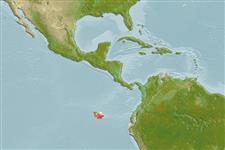Myxini (миксины) (hagfishes) >
Myxiniformes (Hagfishes) >
Myxinidae (Hagfishes) > Eptatretinae
Etymology: Eptatretus: hepta (Gr.), seven; tretos (Gr.), perforated (i.e., with holes), referring to seven gill apertures on what would later be described as Homea banksii (=E. cirrhatus) [range within genus is 6-14 pairs of gill apertures] (See ETYFish); mccoskeri: In honor of American ichthyologist John E. McCosker (b. 1945), California Academy of Sciences, for collecting holotype and for his important contributions to marine biology (See ETYFish).
Eponymy: Dr John Edward McCosker (d: 1945) is an ichthyologist and evolutionary biologist who is Senior Scientist and first Professor of Aquatic Research at California Academy of Sciences, San Francisco. [...] (Ref. 128868), visit book page.
Environment: milieu / climate zone / depth range / distribution range
экология
морской демерсальный; немигрирующий; пределы глубины 155 - 215 m (Ref. 31788). Deep-water
Southeast Pacific: Galapagos Islands.
Size / Вес / Возраст
Maturity: Lm ? range ? - ? cm
Max length : 32.0 cm TL самец/пол неопределен; (Ref. 31788)
Краткое описание
определительные ключи | морфология | морфометрия
This species is distinguished from its congeners, except Eptatretus poicilus by the following characters: gill apertures 8 pairs (7 in one specimen), well-spaced and arranged in a near straight line; a 3/3 multicusp pattern of teeth; differs from Eptatretus poicilus by its number of trunk pores 38-43 (vs. 45-50), by the number of total pores 69-75 (vs. 78-86) and by its colour pattern, with body purple to purplish brown (vs. body strongly mottled with pale brown, dark brown and white-beige) (Ref. 123790).
Life cycle and mating behavior
половая зрелость | размножение | нерест | икра | Fecundity | личинки
Copulatory organ absent. The gonads of hagfishes are situated in the peritoneal cavity. The ovary is found in the anterior portion of the gonad, and the testis is found in the posterior part. The animal becomes female if the cranial part of the gonad develops or male if the caudal part undergoes differentiation. If none develops, then the animal becomes sterile. If both anterior and posterior parts develop, then the animal becomes a functional hermaphrodite. However, hermaphroditism being characterised as functional needs to be validated by more reproduction studies (Ref. 51361 ).
McMillan, C.B., 1999. Three new species of hagfish (Myxinidae, Eptatretus) from the Galápagos Islands. Fish. Bull. 97:110-117. (Ref. 31788)
Статус Красного Списка МСОП (Ref. 130435: Version 2024-1)
Угроза для людей
Harmless
Использование человеком
рыболовство: интереса не представляет
дополнительная информация
инструменты
Специальные отчеты
Скачать в формате XML
ресурсы в Интернет
Estimates based on models
Preferred temperature (Ref.
123201): 8.2 - 14.7, mean 9.6 °C (based on 7 cells).
Phylogenetic diversity index (Ref.
82804): PD
50 = 0.5000 [Uniqueness, from 0.5 = low to 2.0 = high].
Bayesian length-weight: a=0.00204 (0.00094 - 0.00444), b=2.93 (2.74 - 3.12), in cm total length, based on LWR estimates for this (Sub)family-body shape (Ref.
93245).
Trophic level (Ref.
69278): 4.0 ±0.7 se; based on size and trophs of closest relatives
устойчивость к внешним воздействиям (Ref.
120179): низкий, минимальное время удвоения популяции 4.5-14 лет (Fec assumed to be <100).
Fishing Vulnerability (Ref.
59153): Low vulnerability (22 of 100).
